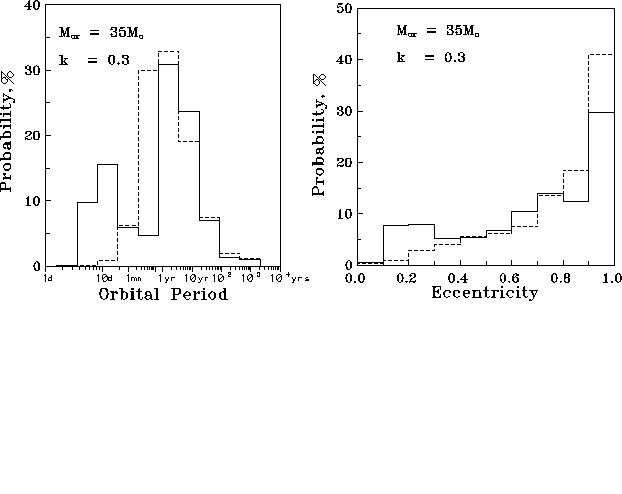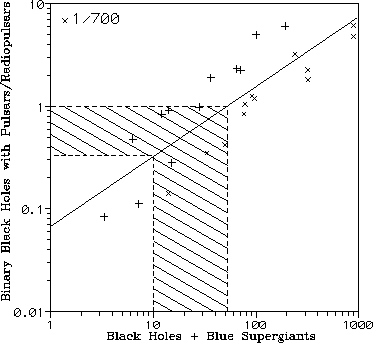Next: Cyg X-1 as a Up: Black Holes in Binaries Previous: Black Hole Creation in
![]()
![]()
![]()
![]()
![]()
Next: Cyg
X-1 as a Up: Black
Holes in Binaries Previous: Black
Hole Creation in
The discovery of binary radiopulsars with massive unseen companions
(>3-![]() ) would be of great importance to fundamental physics and modern theory
of stellar evolution, providing a compelling evidence for the existence
of BH in nature. The formation of binaries consisting of a BH in a pair
with a radiopulsar (PSR) has been discussed previously by Narayan et
al. (1991)[144]. Their estimates
of the total number of NS+NS and BH+NS binaries in the Galaxy (
) would be of great importance to fundamental physics and modern theory
of stellar evolution, providing a compelling evidence for the existence
of BH in nature. The formation of binaries consisting of a BH in a pair
with a radiopulsar (PSR) has been discussed previously by Narayan et
al. (1991)[144]. Their estimates
of the total number of NS+NS and BH+NS binaries in the Galaxy ( ![]()
![]() -
- ![]() ) were derived from the statistics of binary pulsars and current pulsar
surveys. As is well known, observations of a radiopulsar in a binary system
(Hulse and Taylor, 1975[69];
Brumberg et al., 1975[26];
Blandford and Teukolsky, 1975[18])
provide the most accurate information about the physical parameters of
the binary companion. This does not just concern the mass of the companion,
which until now has been the main signature of a BH. The pulsar radioemission
can be used as a probe of the plasma emitted by the secondary star (Lipunov
and Prokhorov 1984[110], Lipunov
et al., 1994a[123]) and,
consequently, by giving a picture of the physical properties of the adjacent
medium, can prove the BH nature of the companion. Some relativistic effects
specific to BH can be observed in these systems, such as propagation of
the radiation through the BH ergosphere.
) were derived from the statistics of binary pulsars and current pulsar
surveys. As is well known, observations of a radiopulsar in a binary system
(Hulse and Taylor, 1975[69];
Brumberg et al., 1975[26];
Blandford and Teukolsky, 1975[18])
provide the most accurate information about the physical parameters of
the binary companion. This does not just concern the mass of the companion,
which until now has been the main signature of a BH. The pulsar radioemission
can be used as a probe of the plasma emitted by the secondary star (Lipunov
and Prokhorov 1984[110], Lipunov
et al., 1994a[123]) and,
consequently, by giving a picture of the physical properties of the adjacent
medium, can prove the BH nature of the companion. Some relativistic effects
specific to BH can be observed in these systems, such as propagation of
the radiation through the BH ergosphere.
We have found that PSR+BH binaries are final evolutionary products of two different types of original binary. In Tables 9 and 10 we show representative evolutionary tracks for both types.
The first type (Table 9) originates
from very massive binaries with high initial mass difference
( ![]() ,
,
![]() ),
so a CE stage is inevitable at the first mass transfer episode. The remaining
massive helium WR-star collapses
further directly to a BH provided its mass
),
so a CE stage is inevitable at the first mass transfer episode. The remaining
massive helium WR-star collapses
further directly to a BH provided its mass ![]() . We note that Cyg X-1-like binaries (BH+OB-supergiant) can be formed in
this way (see the next section for further discussion). The secondary component
(now seen possibly as a Be-star) passes through the
stage of violent mass transfer to the BH (SS 433-like
stage) with supereddington accretion (``SBH'') and
finally collapses to form a NS (as its mass
. We note that Cyg X-1-like binaries (BH+OB-supergiant) can be formed in
this way (see the next section for further discussion). The secondary component
(now seen possibly as a Be-star) passes through the
stage of violent mass transfer to the BH (SS 433-like
stage) with supereddington accretion (``SBH'') and
finally collapses to form a NS (as its mass ![]() prior
to collapse). Thus a young pulsar (ejecting NS) in elliptical orbit around
a massive BH is formed.
prior
to collapse). Thus a young pulsar (ejecting NS) in elliptical orbit around
a massive BH is formed.
The second type of binary BH+PSRs (Table 10)
is a descendant of binaries with lower initial masses ( ![]() -
-![]() )
and moderate mass ratios (
)
and moderate mass ratios ( ![]() 1), so the first mass transfer proceeds more or less conservatively and
the initial secondary becomes more massive. After the first supernova
explosion a young PSR with a Be-star (like PSR B1259-63)
is formed, and then silent collapse of the massive
supergiant to a BH gives rise to a PSR+BH binary in a wide eccentric orbit.
We note that in all calculation runs the contribution of each type of track
to the overall number of PSR+BH varied from 30 to 70 percent, depending
on parameters.
1), so the first mass transfer proceeds more or less conservatively and
the initial secondary becomes more massive. After the first supernova
explosion a young PSR with a Be-star (like PSR B1259-63)
is formed, and then silent collapse of the massive
supergiant to a BH gives rise to a PSR+BH binary in a wide eccentric orbit.
We note that in all calculation runs the contribution of each type of track
to the overall number of PSR+BH varied from 30 to 70 percent, depending
on parameters.
úÄÅÓØ ÄÏÌÖÎÁ ÂÙÔØ Table 11 (Note Ë Table 11)

In Table 11 we show the number of
calculated binary pulsars with a NS, BH or WD companion, normalized to
all PSR formed from single and binary systems in a 500 000 run. For comparison
we estimated the galactic numbers of the same binary types (taken from
van den Heuvel, 1991[204]), normalized
to the number of known pulsars (taken as 700). This permits us (partially,
of course) to get rid off selection effects. The numbers are shown in dependence
on two principal parameters of binary NS formation, ![]() and
and ![]() .
We have assumed that if a star collapses to form a NS (in other terms,
if the presupernova mass
.
We have assumed that if a star collapses to form a NS (in other terms,
if the presupernova mass ![]() ),
the remnant acquires an additional (kick) velocity of 75 km s
),
the remnant acquires an additional (kick) velocity of 75 km s![]() . The need for such a kick velocity follows from a statistical analysis
of radiopulsars with OB-companions (Kornilov and Lipunov,
1984[87]; Dewey and Cordes,
1987[45]; see, however, Lipunov
et al., 1995d[128]). In
the case of collapse into a BH (
. The need for such a kick velocity follows from a statistical analysis
of radiopulsars with OB-companions (Kornilov and Lipunov,
1984[87]; Dewey and Cordes,
1987[45]; see, however, Lipunov
et al., 1995d[128]). In
the case of collapse into a BH (![]() )
we considered both isotropic and anisotropic collapse. The first set of
models (upper rows in Table 11) was
calculated under the assumption that the BH remnant acquires no recoil
velocity, whereas in the second set we introduced the kick velocity
proportional to the mass lost during the collapse,
)
we considered both isotropic and anisotropic collapse. The first set of
models (upper rows in Table 11) was
calculated under the assumption that the BH remnant acquires no recoil
velocity, whereas in the second set we introduced the kick velocity
proportional to the mass lost during the collapse, ![]() .
These models are shown in the bottom rows of Table 11
and are marked by a letter with an asterisk. As a separate independent
criterion we included the calculated galactic number of BH candidates (BHC)
with evolved OB-companions. The observational estimation
.
These models are shown in the bottom rows of Table 11
and are marked by a letter with an asterisk. As a separate independent
criterion we included the calculated galactic number of BH candidates (BHC)
with evolved OB-companions. The observational estimation ![]() 10 per Galaxy is given by a fraction (
10 per Galaxy is given by a fraction ( ![]() 1/4) of the BHC among the observed number of bright massive X-ray binaries
(MXRB), scaled to the total galactic number of MXRB (
1/4) of the BHC among the observed number of bright massive X-ray binaries
(MXRB), scaled to the total galactic number of MXRB ( ![]() 40, see van Paradijs and McClintock, 1993[208]).
40, see van Paradijs and McClintock, 1993[208]).

Figure 33: The calculated distributions of BH+PSR binaries on
orbital periods (left-hand panel) and on eccenticities (right-hand panel).
Solid line marks the case without anisotropy of the collapse to BH, dashed
line corresponds to the anisotropy of the BH formation (see the text) (Lipunov
et al., 1994b).
The observational data from Table 11
(second column) impose some restrictions on the parameters ![]() and
and ![]() .
It is seen from this table that lower values of
.
It is seen from this table that lower values of ![]() are
less likely. Too low values of
are
less likely. Too low values of ![]() would
give too ``light'' BH with masses in the range 3-
would
give too ``light'' BH with masses in the range 3-![]() , and the large mass loss during the collapse would
make binaries with high mass ratio unbound, so it would be difficult to
understand how low-mass binary BH candidates with high mass ratios observed
now as X-ray novae had been formed. Higher values of
, and the large mass loss during the collapse would
make binaries with high mass ratio unbound, so it would be difficult to
understand how low-mass binary BH candidates with high mass ratios observed
now as X-ray novae had been formed. Higher values of ![]() require higher values of
require higher values of ![]() ,
giving more massive BH. Here, again, uppermost values for
,
giving more massive BH. Here, again, uppermost values for ![]() -0.7
are less likely according to the most probable estimation of BH mass in
Cyg X-1
-0.7
are less likely according to the most probable estimation of BH mass in
Cyg X-1 ![]()
![]() . These considerations make us favor the values
. These considerations make us favor the values ![]() ,
,
![]() . This mass corresponds to the initial mass of the star of
. This mass corresponds to the initial mass of the star of ![]() 60-70
60-70 ![]() .
.

By adopting these parameters, we calculated binaries to find expected distributions of binary BH+PSR on orbital periods and eccentricities (Figure 33)
Solid lines in the histograms in Figure 33 correspond to calculations without anisotropy, dashed lines, with the anisotropy of BH formation as described above.
The statistics obtained do not account for the BH binaries that could be formed in dense globular stellar clusters and then expelled from there due to possible stellar encounters (Kulkarni et al., 1993[91]). However, at present there are no reliable estimates of such events in the Galaxy.